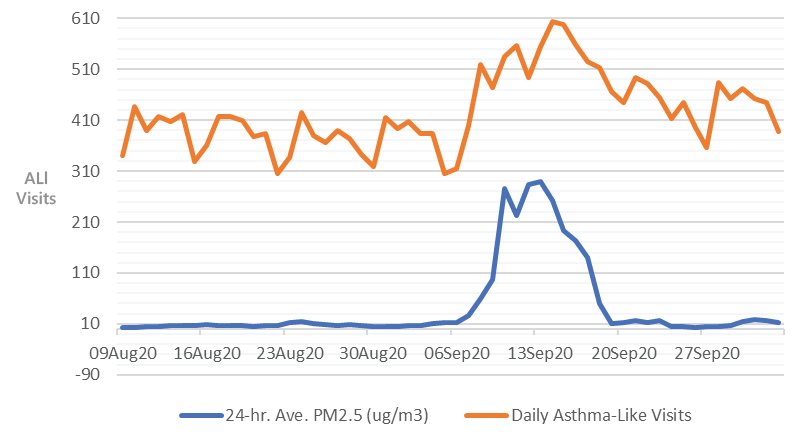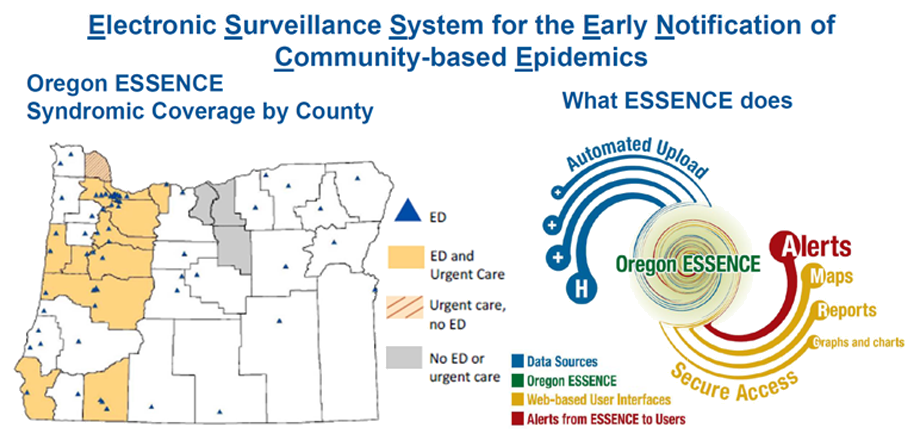Air Quality and Asthma-like Illness in Oregon During Wildfires

The 2020 Oregon wildfires were unprecedented. Nine people lost their lives, over 1 million acres burned, and more than 4,000 structures were destroyed. Wildfire smoke is especially dangerous because it can affect geographic areas and populations far outside the burn zone. Smoke from a wildfire not only causes general health problems in those exposed, but it can also worsen chronic respiratory and cardiovascular health conditions. Across Oregon, the air quality became increasingly unhealthy, triggering health alerts.
Public health analysts used syndromic surveillance to monitor air quality and better understand the effect of wildfire smoke on Oregon residents. Syndromic surveillance is an early-detection method that uses electronic health data collected in near-real time when people seek care in hospital emergency departments and urgent care centers. Analysts use syndromic data to understand who is being affected, and how, and to understand the health threat, its spread, and trends. Syndromic surveillance systems allow analysis of syndromic data in combination with other data; for example, asthma-like illness (syndromic data) can be analyzed with levels of pollutants in the air during the wildfires.
Syndromic surveillance gave Oregon the capacity needed to better monitor not only the devasting impact of the wildfires on the public’s health, but also the burden being placed on healthcare resources. Syndromic data helped to identify vulnerable populations, indicating, for example, a 25% statewide increase in people seeking care for asthma-like illness. Visits for asthma-like illness among Hispanic or Latino populations in Oregon were 30.0% higher during wildfires compared to just over 22% higher for non-Hispanic or Latino populations during the same period. Syndromic data were also used to inform emergency preparedness and risk communication during the wildfires. Through funding from CDC to support the National Syndromic Surveillance Program, syndromic surveillance is improving the nation’s public health.
Public Health Problem
The 2020 Oregon wildfires were unprecedented. Nine people lost their lives, over 1 million acres burned, and more than 4,000 structures were destroyed. Wildfire smoke caused multiple adverse health effects and exacerbated chronic respiratory and cardiovascular health conditions. Air quality levels were unhealthy in many parts of the state for 12 days or more in September, triggering health alerts and increasing hospital visits.
Actions Taken
Oregon’s public health analysts used the state’s syndromic surveillance system, OR–ESSENCE, to collect electronic health data. These data, collected in near-real time when people seek care in hospital emergency departments and urgent care centers, serve as a key early detection method. Oregon used these data to monitor the effects of the wildfire on the public’s health and the burden being placed on healthcare facilities. By combining syndromic data with other data sources, the analysts could characterize asthma-like illness (ALI) during a period of high pollution (fine particulate matter: PM2.5) from the Oregon wildfires. They analyzed ALI emergency department and urgent care visits and PM2.5 air quality data from OR–ESSENCE statewide and by county, summarizing ALI visits and 24-hour average PM2.5 for a 4-week period from September 6, 2020, through October 3, 2020. Once they identified unhealthy air quality levels across large areas of the state during the “wildfire” period, the analysts could compare these data with the preceding 4-week “reference” period. ALI visits were stratified statewide by race and ethnicity.
Outcome
The use of syndromic surveillance helped to identify vulnerable populations. ALI visits among Hispanic or Latino populations in Oregon were 30.0% higher during wildfires compared to 22.4% higher for non-Hispanic or Latino populations during the same period. The statewide overall increase (not stratified by ethnicity) was 24.9%. ALI statewide rates were elevated by 2.2 daily visits per 100,000 population during the wildfires. Changes in daily visit rates per 100,000 during the wildfires by race follows: Black or African American +1.2 daily visits (+10.0%), American Indian/Alaska Natives +0.9 daily visits (+9.1%), and Asian +0.3 daily visits (+7%). (The Native Hawaiian/Pacific Islander group had no change in daily visits during wildfires compared to reference period.)
Statewide 24-hour average PM2.5 measured 63.5 micrograms per cubic meter (ug/m3) during the wildfire period compared with 7.7 ug/m3 for the reference period, which is an increase of 765% (Figure 1). PM2.5 was elevated during the wildfires for 29 of 36 counties for which PM2.5-monitored data are available. County increases in 24-hour average PM2.5 during the wildfires ranged from 44% to 2652%.
Syndromic surveillance data were also used to inform emergency preparedness and risk communication during the wildfires. Syndromic data not only benefitted Oregon’s understanding and mitigation of the wildfires, but the versatility of syndromic surveillance makes it a valuable tool in the identification, characterization, monitoring, and response to other public health threats as well.
Statewide September 2020 Wildfire Health Impacts

Figure 1. Emergency department asthma-like visits from near real-time syndromic surveillance (OR–ESSENCE) and daily statewide maximum PM2.5 (ug/m3) particulate matter in Oregon from August–September 2020.
Oregon Facilities Use ESSENCE for Syndromic Surveillance

Contact
Carol A. Trenga, MS, PhD
Oregon Health Authority
Public Health Division
Environmental Public Health
carol.a.trenga@state.or.us
Center for Surveillance, Epidemiology, and Laboratory Services
Division of Health Informatics and Surveillance
www.cdc.gov/nssp
This success story shows how NSSP
- Improves Data Representativeness
- Improves Data Quality, Timeliness, and Use
- Strengthens Syndromic Surveillance Practice
- Informs Public Health Action or Response
The findings and outcomes described in this syndromic success story are those of the authors and do not necessarily represent the official position of the National Syndromic Surveillance Program or the Centers for Disease Control and Prevention.
